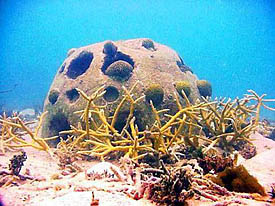For
Burial at Sea, You Need Not Be a
Sailor
|
Thursday, March 21,
2002 |
| |

Concrete
domes such as this one are being used to create
artificial reefs and, increasingly, as burial
sites.
(Washington Post)
| BY
DON OLDENBURG
THE WASHINGTON POST
Stephen Emery
pulled himself slowly down the motorboat's anchor chain,
20 feet to the dark bottom of Florida's Sarasota Bay.
Above, choppy waters had made the two-mile ride bumpy
and mucked up the water, but as he touched bottom the
visibility cleared some, and "there it was," he
recalled.
The anchor had hooked
into a hole in a large concrete dome, one of four
settled into the sand, ranging from 2 to 4 feet in
diameter. Together they made an artificial reef, which
was so completely covered by algae, barnacles, soft
coral and small sponges that Emery couldn't find the
bronze plaque he was looking for.
The plaque bears his twin brother's name. The cremated
remains of David Emery, who died at 32 when a drunk
driver hit his motorcycle, are in one of those
algae-covered concrete domes.
"The growth was phenomenal," said Stephen, an
environmental scientist who made his first scuba dive to
visit his brother's burial site last Dec. 23. "I felt,
hey, this isn't too bad. I was near where Dave is. He's
part of that reef. And I felt that's where he'd want to
be."
Not long ago, people seemed
satisfied to bury their dearly departed in cemetery
plots or keep their ashes on the mantel. But as views of
death and dying change, more people are thinking outside
the box. A growing number believe alternative
dispositions such as reef burials could change the face
of the burial business.
Last
weekend the Cremation Association of North America's
two-day seminar in Las Vegas concluded with a session
called "It's Not Your Grandparents' Funeral," which
included memorial paintings by a company called
Eternally Yours that blend the deceased's ashes into
watercolors. There were also several "green" options:
Celebration Forest in Idaho will plant and care for a
memorial tree, and scatter the ashes around its trunk. A
"nature preserve" cemetery in South Carolina buries
bodies in an ecologically sound way. And people who love
the ocean can choose artificial reefs.
"It's a niche type of thing, but
the niche is growing," said Jack Springer, the
association's executive director.
For decades, cremation was the niche. But the percentage
of bodies cremated went from less than 7 percent in 1975
to 25 percent in 2000 in the United States, according to
the association. Despite the gross abuses discovered
last month at Georgia's Tri-State Crematory, cremation
rates are expected to rise steadily and top 50 percent
in 25 years.
But disposing of a
loved one's ashes provides an opportunity to deal with
death in a more meaningful way. George Frankel,
co-founder of Eternal Reefs, the company that buried
Dave Emery's ashes, said people are beginning to
consider the impact their remains will have on the
environment.
Based in Decatur,
Ga., Eternal Reefs is a spinoff from the Reef Ball
Development Group, created in 1992 by a group of
ecology-conscious diving buddies who wanted to
revitalize endangered coral reefs. Hired primarily by
governments, the company has sunk more than 100,000
"reef balls" in 1,500 locations worldwide to build
artificial reefs.
"Each reef ball
is designed to last 500 years," Frankel said. Six inches
thick and made from marine-grade, pH-neutral concrete,
reef balls range from 400 to 4,000 pounds.
Four years ago, when one
partner's dying father asked to be buried in an
artificial reef, Reef Balls got into the business.
Eternal Reefs has "deployed" the ashes of nearly 100
people off Charleston, S.C., and Sarasota, at a cost of
$850 to $3,200 each.
|
| |
| © Copyright 2002, The
Salt Lake Tribune All material found on Utah OnLine is
copyrighted The Salt Lake Tribune and associated news
services. No material may be reproduced or reused
without explicit permission from The Salt Lake Tribune.
| |
|
|

